Make the most of your hunting and fishing licenses
December is here, which means some hunters and anglers stash away their guns and rods until spring. But many savvy outdoors people know there’s still plenty of things to hunt and fish for during December and throughout winter. And don't forget that 2024 hunting, fishing and trapping licenses are now on sale.
Folks from each Idaho Department of Fish and Game region came up with some popular, or overlooked, ways to make hunting and fishing a 12-month pursuit.
Boise River trout/whitefish fishing
You could don waders, grab a fishing rod and walk from Boise Capital through downtown to the river in minutes, and no one would probably give you a second glance. The river has countless access points along the Greenbelt, fairly easy wading, and, as a bonus, Fish and Game stocked several hundred steelhead in the river during November. The river is also a magnet for wintering wildlife from beavers to bald eagles to mule deer. And if you get a little chilly, there’s probably a coffee shop nearby. You may have to change out of your waders, but hey, it’s Idaho, so maybe not.
Roger Phillips, Idaho Fish and Game Public Information Supervisor
Upper Snake waterfowl hunting
Waterfowl hunting still continues to be good after the still water freezes for those willing to hunt fields or river systems in the Upper Snake Region. If you can find open water, chances are you will find ducks nearby.
James Brower, Regional Communications Manager, Upper Snake Region
Kootenai River burbot fishing
Burbot may be Idaho’s most unique fishery, although sturgeon anglers may have a credible counter argument. Considering burbot (AKA ling, lawyers, leopards and eelpout) are the only freshwater cod species in North America, it's a pretty accurate description.
The Kootenai River in the Panhandle is the only waterbody in Idaho where burbot are native. After a successful restoration project between Idaho Fish and Game, the Kootenai Tribe and others, the Fish and Game Commission reopened burbot fishing in 2019. The best angling is during winter, and mid-February through mid-March tends to be the best period, but they start staging in the river in December and you can catch this unique, and tasty, Idaho fish.
Andy Dux, Panhandle Region Fisheries Manager
Owyhees upland/small game hunting
The Owyhee Desert is big, big country that stretches across southern Idaho and has a diversity of wildlife. It’s best known for its big game and chukar hunting, but there’s a variety of hunting opportunity. The area has cottontail rabbits and jackrabbits. If you’re a predator hunter, lots of coyotes roam in the Owyhees. You could spend months exploring and only see a fraction of it. Beware of wet weather, that mud is super slick and make sure your vehicle can withstand some rough terrain.
Brian Pearson, Regional Communications Manager, Southwest Region
Ice fishing Henry’s Lake
Fishing the world-famous Henry's Lake tops most people’s to-do list the second it caps over with ice. Be sure to test the ice thickness to ensure that it will bear the weight of the massive trout you are about to catch. Learn more on Fish and Game's ice fishing webpage.
James Brower, Regional Communications Manager, Upper Snake Region
Southwest Idaho duck hunting
Many of the shallow ponds and marshes in southwest Idaho are beginning to look more like ice-skating rinks than waterfowl honey holes. Early in the winter, you may have some luck stomping through the ice in these places to open up a bit of water, but that quickly goes out the window when an inversion settles in and daytime highs end up near freezing for an extended period of time. At that point, it’s time to look to bigger water (think Lake Lowell or C.J. Strike) or moving water (the Snake, Boise, Payette, or even Weiser rivers).
While a boat helps this time of year, there are still viable walk-in opportunities to be had. Just be sure to pack light on the decoys, and don’t be afraid to shed some extra weight by leaving the calls at home. Regardless of how good a duck caller you are, the birds have heard enough of your chatter, so you may find less is more.
Brian Pearson, Regional Communications Manager, Southwest Region
Fish local ponds
Many ponds in Idaho, particularly those at lower elevations, get stocked with catchable trout almost year-round. The beauty of these locations is that they are usually pretty close to home, so bundle up and go drown a worm or an hour or two and, hopefully, you’ll bring home some trout. Watching a bobber bounce and make a ripple is fun regardless of the weather.
Roger Phillips, Idaho Fish and Game Public Information Supervisor
Get squirrelly
Need an excuse to get outside and take your .22 or small-gauge shotgun for a hike? Look no further than red squirrel hunting. Going after red squirrels (also known as pine squirrels) is arguably one of the easiest winter hunting pursuits and can be achieved in nearly every part of the state; they’re abundant, they’re noisy and they’re quite tasty. You don’t need specialized or expensive gear to hunt them, just a .22 long rifle and/or any shotgun, warm clothes and boots suitable for hiking.
You’ll notice the squirrels have changed their tune a little bit from summer and fall, when they tend to be a little more vocal and active collecting pinecone seeds. During winter, squirrels are still active, but not nearly as vocal, so keep your eyes up as you trudge through the woods.
Another hot tip, if you’re not hearing or seeing any squirrel action up in the canopy, cradle your firearm and let out a few loud claps. This can sometimes rattle the squirrels enough to move to another pine bough, which, with a keen eye, can quickly get you on their trail. Don’t forget to bring your dog. Nearly any dog loves to chase a squirrel, so they can help you locate them. If the squirrel is focused on the dog, it could help you get a shot.
Connor Liess, Fish and Game Public Information Specialist
Salmon River steelhead fishing at Riggins
The stretch of river between Riggins and Whitebird typically stays ice-free most of the winter, and it’s common to see jetboats and driftboats on the water. There’s also excellent bank access because U.S. 95 runs along the river for miles, and the river holds a lot of steelhead that are wintering before their final push upstream in the spring. With colder water, the fish tend to slow down, so adjust your tactics accordingly, but rest assured, a lot of steelhead get caught during winter.
Roger Phillips, Idaho Fish and Game Public Information Supervisor
Old-school Idaho trapping
Hardiest among the winter adventurers are the trappers. Many areas in the Upper Snake and elsewhere in Idaho are open for trapping furbearers beginning Oct. 22. Trapping is a challenging way to get outside and test your grit against the elements and knowledge of animal behavior. A trapper education course is required, and you can find classes near you.
James Brower, Regional Communications Manager, Upper Snake Region
Go watch wildlife
OK, you don’t need a license for this, so consider it a bonus. Winter wildlife watching is a pretty cool (or cold, depending on the day) way to temporarily leave the guns, hiking boots or waders at home and just go appreciate nature. Drive your favorite backroad and watch for animals. That buck you swear didn’t exist in October may be casually feeding in the open in broad daylight. Bring your binoculars and/or spotting scope and observe from a distance so you don’t disturb wintering big game. Check out waterfowl coming and going to open water, or spot wintering bald eagles, which are common along many of Idaho’s rivers and large lakes and reservoirs. Seeing flock after flock of waterfowl winging in as the sun sets is a wonderful winter experience.
Roger Phillips, Idaho Fish and Game Public Information Supervisor





